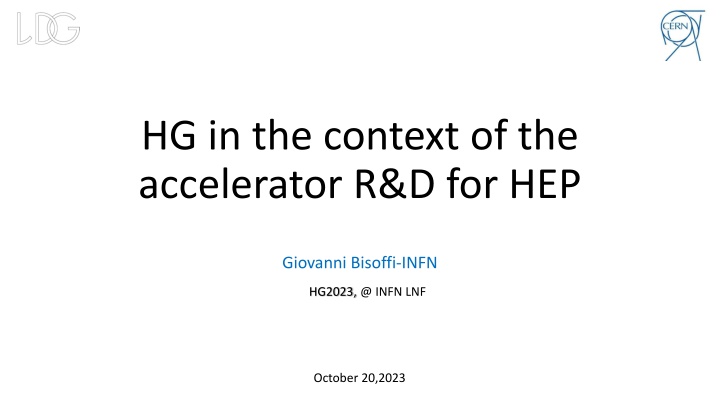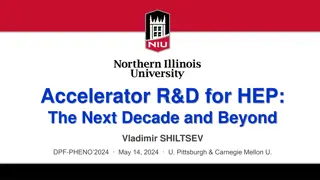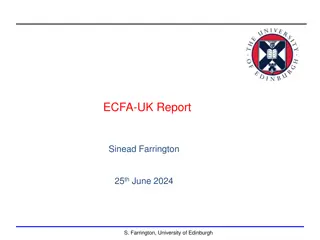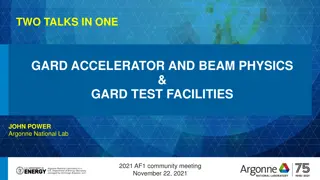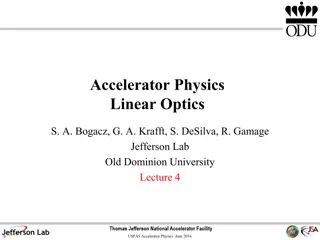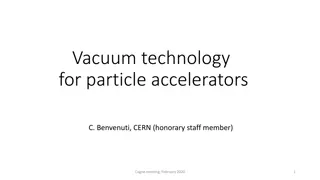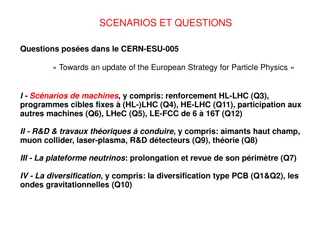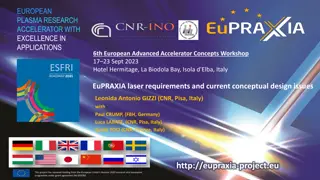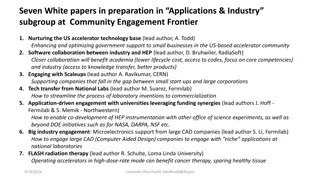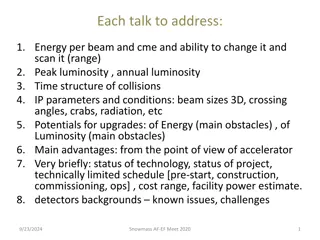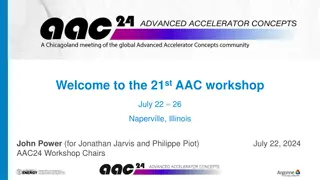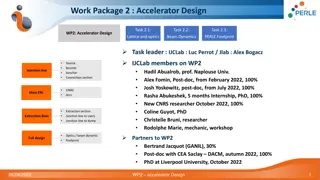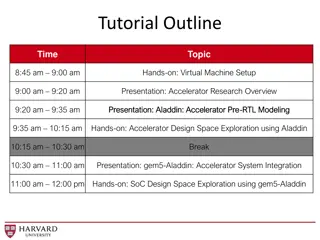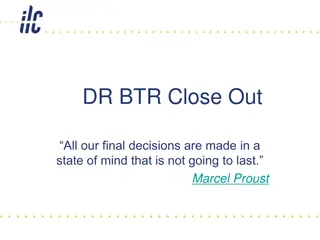European Particle Physics Strategy Update & Accelerator R&D Overview
European Particle Physics Strategy updates serve as the cornerstone for long-term decision-making in the field, with a focus on Accelerator R&D for High Energy Physics. The update process involves key questions, R&D strategies for RF technologies, and implementation plans. Approved strategies emphasize e+e- programs, sustainability, and resource allocation for future collider options. An Accelerator R&D Roadmap has been developed and is set for implementation by expert panels and the particle physics community.
Uploaded on Apr 05, 2024 | 15 Views
Download Presentation

Please find below an Image/Link to download the presentation.
The content on the website is provided AS IS for your information and personal use only. It may not be sold, licensed, or shared on other websites without obtaining consent from the author.If you encounter any issues during the download, it is possible that the publisher has removed the file from their server.
You are allowed to download the files provided on this website for personal or commercial use, subject to the condition that they are used lawfully. All files are the property of their respective owners.
The content on the website is provided AS IS for your information and personal use only. It may not be sold, licensed, or shared on other websites without obtaining consent from the author.
E N D
Presentation Transcript
HG in the context of the accelerator R&D for HEP Giovanni Bisoffi-INFN HG2023, @ INFN LNF October 20,2023
European Particle Physics Strategy and its updates ( ) cornerstone of Europe s decision-making process for the long-term future of the field. Mandated by the CERN Council, it is formed through a broad consultation of the grass-roots particle physics community ( ) and it is developed in close coordination with similar processes in the US and Japan ( ) Update 30 May 2013 Strategy 14 July 2006 Update 19 June 2020 CERN Council: decision making body, coordinating particle physics in Europe (23 Member States)
20202027 Strategy update process timeline European Strategy Group (ESG) Chairperson 1/CERN Member State, 1/lab of the major European Laboratory Directors Group, LDG CERN Director-General, SPC Chairperson, ECFA Chairperson. Invitees: President of the CERN Council, 1/Associate Member States, 1/Observer State, 1/European Commission, JINR Chairs of ApPEC, FALC, ESFRI, and NuPECC Members of Physics Prep Group End of 2024, start of the nex exercise ! 05/04/2024 3
European Strategy Update and Accel R&D HF magnets, HG RF structures and systems, HG plasma and laser accelerators, m colliders, Energy Recovery Linacs Key questions during the 2020 Strategy Update on R&D for future collider options: What R&D? which priorities? How long might it take? How much will it cost? Which science with demonstrators, or intermediate-scale facilities? Which new infrastructures? Authors of RF R&D strategy: S. Bousson (IJCLab), Hans Weise (DESY). G. Burt (Lancaster University); G. Devanz (CEA); A. Gallo (INFN LNF); F. Gerigk (CERN); A. Grudiev (CERN); D. Longuevergne (IJCLab); T. Proslier (CEA); R. Ruber (Uppsala University), plus added experts Superconducting RF: bulk niobium cavities, surface preparation, thin films NC structures: fundamental limitations, surface preparation, manufacturing techniques Strategy Update mandated a large-scale programme of accelerator R&D to inform and support future decision-making in the field High power RF sources, accelerating structures ancillaries (couplers, tuners ), LLRF and AI
Approved R&D strategy and its implementation https://doi.org/10.23731/CYRM-2022-001 Each technology area deeply surveyed Key R&D objectives, deliverables (at 5 and 10 years) Resource estimates, needed facilities Emphasis on: e+e- programme and sustainability Accelerator R&D Roadmap adopted and presented to SPC in March 2022 After that: an expert coordination panels, working with LDG ( extended LDG ) and accelerator R&D community was assigned to begin the concrete implementation of the roadmap recommendations
European Laboratory Directors Group (LDG) Remit by CERN Council: o Dialogue among Lab Directors and CERN o Input to the ESPP, liaise with EU Commission and national funding agencies, institutes and universities o Maximise national benefits of investment in fundamental research and in CERN o Look at activities outside CERN s Member States, and of other groups in PP and related fields Standing observers Lab representatives K. Jakobs (ECFA Chair) M. Lamont (CERN Directorate) J. Mnich (CERN Directorate) H. Montgomery (SPC Chair) S. Bentvelsen (NIKHEF) F. Bossi (LNF) J. Clarke (DL) N. Colino (CIEMAT) F. Gianotti (CERN) B. Heinemann (DESY) D. Newbold (RAL) E. Previtali (LNGS) F. Sabatie (IRFU) M. Seidel (PSI) A. Stocchi (IJCLab) Secretary E. Tsesmelis (CERN) Extended LDG members o Draw up and maintain a prioritised accelerator R&D roadmap towards future large-scale facilities for PP o Coordinate the accelerator R&D activities on the roadmap, until the next SU G. Bisoffi (for RF) + P. Macintosh W. Leemans (for LPA) + R. Patahill S. Stapnes (for Muons) + D. Schulte J. D Hondt (for ERL) + M. Klein P. Vedrine (for HFM)
LDG and the and Acc R&D Coordination panels (~ feasible start dates) The 5 R&D Themes 1. High-field magnets Scope R&D needs Teams Time horizon 2. High-gradient plasma and laser accelerators 3. Bright muon beams and muon collider 4. Energy Recovery Linacs 5. High-gradient RF structures and systems
1. High Field Magnets HFM Key for new colliders, beyond the LHC Goals (on conductor and magnets): 16 T Nb3Sn technology (large-scale, industry- optimised) for FCC-hh, demonstration before 2026 20 T at 10 20K with HTS (proof-of-principle, tapes and cables with industry) Decades needed, broad expertise and coordination, infrastructures, industry: CARE, EUCARD, EUCARD2, ARIES, now I-FAST, CERN-High Field Magnet and US-MDP Cross-cutting activities: materials, powering and protection, infrastructures and instruments, quench detection and protection New infrastructures needed! 12 T prototypes expected in INFN-Ge and CERN by 2025; CEA: a 16 T prototype plan Focus on stress/strain sensitivity and degradation of Nb3Sn: mech. strength, higher JC, stress- adapted magnet design Hybrid LTS/HTS magnets: ReBCO tapes or Bi-2212 cables (still a long way to go for 16 T)
2. Muon Collider 5 GeV p p m, cooled and accelerated at 3/10 TeV 3/10 TeV m acceleration via RLA/FFAG and RCS (with 14 T Magnets) For long-term sustainability of collider physics: strong suppression of synchrotron radiation (m vs. e) power consumption at 10 TeV lower than CLIC at 3 TeV; L/Pbeamincreasing with collision energy Needed: a fully integrated design (on target, detector, cooling and accelerator chain) Needed from SRF technology: e.g. HG room-T cavity in high- field SC solenoid, 20 T solenoids (HFM), ERL linac MuCol Collaboration: 32 partners Institutions in Europe, plus USA (waiting for P5), China, India: 7-15 M thus far After 2026, CDR R&D with a m-cooling demonstrator After the target: 200 mm bore 15 20 T solenoid (synergy with fusion) Cooling channel demonstrator is key: HG room-T cavity in high-field SC solenoid
3. Colliders based on Energy Recovery Linacs LHC/FCC-based electron-hadron Collider Multipass accel/decel (energy efficient) Linac beam quality, ring high Iave ERL-based colliders: LHeC, FCC-eh, CERC, ERLC Current facilities: S-DALINAC (Darmstadt), MESA (Mainz), CBETA (Cornell, US), cERL (KEK), Recuperator facility (BINP) New ERLs: Berlin-PRO, PERLE, CEBAF5, ERL- ecool at EIC Collaboration: iSAS project approved (July 10, 2023): 1000 person*months, 12.6 M , 4 years Needed from SRF technology: Q~1011 at higher T (4K); HOM extraction at high-T; FE-FRT to control transient beam loading and microphonics; dual-axis cavities; ... Circular ER Collider Energy Recovery Linear Collider
4. High-gradient plasma and laser accelerators Electron bunch or laser (v~c) induce wave-like separations of electrons from ions (~ at rest) Experimental studies on key R&D: e+ bunch acceleration, sufficient bunch charge, nm-scale emittance, staging of multiple structures, spin- polarisation preservation, high rep-rate and power handling, high rep-rate lasers, energy efficiency. Driving discipline is photon/material science: ELI and EuPRAXIA distributed facilities. R&D strategies at CERN (AWAKE), CLARA, CNRS, DESY, Helmoltz s, INFN, RAL, and abroad. HEP-related programmes: EU (EuroNNAc), the US (DOE) and world-wide (ALEGRO). Pre-CDR and Collider Feasibility Report (2025), CDR in 2026-2030 with demo of technical parameters. A collider option beyond 2050 (after FCC-hh) HALHF A proposed collider scheme HALHF, with both RF and PBA: e- 500GeV electrons onto e+ 31GeV positrons
5. High gradient RF structures and systems G. Bisoffi INFN-I, P. McIntosh STFC-UK M. Baylac CNRS-F, C. Madec CEA-F, L. Monaco INFN-I C. Antoine CEA-F, O. Malyshev STFC-UK F. Gerick CERN-CH, E. Montesinos CERN-CH, A. Neumann HZB-D W. W nsch CERN-CH, D. Alesini INFN-I I. Syratchev CERN-CH, G. Burt ULAN-UK, M. Jensen ESS-SE Z. Geng PSI-CH, W. Cichalewski U-Lodz-P Topics of the RF theme: RF Implementation Panel WG1 Bulk Nb WG2 Thin films WG3 Couplers WG4 NC High gradient WG5 RF Power sources WG6 LLRF, AI, ML GOAL Per year: 10 M , 90 FTE (nominal, ~30% higher than actual - ref. Accelerator R&D strategy)
SRF Cavities: reduce operational cost (Q0) and capital cost (Eacc) Cavity types mostly elliptical: 1.3 GHz (3.9 GHz), 802 MHz (401 MHz), 704 MHz (352 MHz), 650 MHz (325 MHz). (mature) Niobium (Tc=9.2K, Tcryo= 2K is mandatory) Eacc> 40 MV/m, Q0 > 1010 Theoretical limits close? 57 MV/m s.h. . ?0=2??0? ????? vs. Eacc NEEDS: Higher Eacc ILC higher Eacc smaller linac (= lower capital cost) MC quick acceleration (vs m-lifetime) FCC fewer cavities smaller RF installation (R&D goal) Thin films (higher-TCmaterials) Eaccx 2 higher than Nb ( 100 MV/m); Q0>1010 at Tcryo=4.2K (66% saving in Pele,cryo) 40% cryo-plant cost saving (cryocoolers?)) Higher Q0 FCC, ERL, ILC lower RF losses, cryogenic power minimised. Others: Reproducibility, cost, industrial manufacturing
WG1: Niobium cavities WG2: Thin-film cavities Goals: high Q0 @ 4.2K; much higher Eacc. Nb3Sn/Nb 1.`Further increase Q and Eacc: surface polishing, treatment (N doping), low/mid/2-step baking, H degas). 2. Improve reproducibility of high-Eacc fields: robots in clean room, in-situ plasma processing. 3. Reduce the cost: Fine Medium Grain 4. Risk of losing manufacturing capability? - Maintain SRF technology skills in both labs & industry. - Invest in industrial processes (FCC ~1000 cavities, ILC - 8000 cavities). A15 materials: Nb3Sn-on-Nb (USA). Nb3Sn-on- Cu (IFAST EU project, on going) SIS (multi-layer): higher performance, less defect-sensitive (sample cavity, CEA). Cu cavity base production R&D: spinning (CERN, INFN), 3D-printing; Cu-surface preparation. CERN (CH), CEA and IJCLab (F), DESY, HZB, Hamburg- Uni (D), INFN (LASA, LNF, LNL), STFC (UK) CEA-Saclay, CERN, HZB, HZDR, INFN, STFC, USI, Hamburg U. (DESY), (I.FAST-WP) JLAB, KeK and FNAL 14
WG3: Fundamental power couplers (FPC) and HOM 1. Ceramic window! No leak allowed vs. cavity and entire machine, low losses at operating f and T, but brazed, low T-gradient 2. CERN SPS resonant ring Transmitting hundreds of kW (W s in the cold mass) reliably through thin ceramic windows (diameter ~ 5 50 cm) into SRF cavities. 3. Fast Reactive Tuners (potential game changer for tuning, transient beam loading, microphonics) FCCee (Z W,H ttb modes): 112 864 couplers, CW, 400-800 MHz, P = 165 - 900 kW MC (SC driver, NC RF, SC RCS): 250, 7000, 4500 couplers, dc 0.05% 4%, 325-1300 MHz, P= 100 - 4000 kW (for ILC and CLIC: FP specs achieved) FABRICATION CAPABILITIES, TEST STAND CERN: for future colliders, long-term expertise; couplers for Soleil, ESRF, PERLE, - CEA: couplers on request for XFEL, ESS DESY: 1.3 GHz CW couplers RI company EIC (USA): couplers with challenging specs, developments will benefit next colliders. HOMs couplers (see iSAS proposal): R&D on 800, 1300 MHz multicell; ~ kW RF power out of the cold mass
WG4: HG Normal-Conducting RF Achieved: Gradient; understanding of fundamentals physics; industry on NC RF components/systems; synergies (XFEL, Eupraxia, ICS, medical, plasma accelerator, RFQ, ) Generated: dielectric structures, short pulse acceleration and HT superconductors. Required: systems engineering, integration, mechanics R&D, design, m mm-level alignment. Fundamentals of breakdown: on ED, materials, plasma, surface physics CLIC HG (70 to 100 MV/m), X-Band with very low breakdown rate, key for cost (linac length) and efficiency (BD). Good alignment mitigates HG/BD interplay (wakefields). Muon Collider Muon capture: HG with high external magnetic field. FCC-ee 20 GeV NC injector; FCC-hh E-separators (S and C- Band). Synergic with applications outside HEP (60 - 70 MV/m) Operational test infrastructures: CERN (n.3, 50 MW, 12 GHz), Trieste (45 MW, 3 GHz), Valencia (7.5 MW, 3 GHz), Frascati (50 MW, 12 GHz), Uppsala (cryo pulsed DC sys) X-band linearizers and deflectors: PSI, DESY, STFC Linac design, operation: INFN (Roma and LNF), CERN, PSI, Eindhoven, Elettra, Medical VHEE, FLASH
WG5: High Efficiency Amplifiers FCCee High efficiency RF power sources for future large- scale particle accelerators (LHC and FCCeefirst) In collaboration with industry to secure to ensure decades of industry support. 105 MW from 380 klystrons and 600 SSPAs Only large projects can afford R&D costs and risks, which benefit many applications; for small labs energy savings are not worth R&D investment. Klystrons (CERN, Lancaster, ESS, CEA): R&D expensive, today done soley with industry (3 qualified vendors!). 50-100% cost increase in last ~5 yrs. SSPA (CERN, Uppsala, CEA Saclay, INFN-Legnaro, NCBJ (Swierk), CIEMAT): industry on transistor (and h) R&D; labs contribute with combination/matching techniques 3.0 TeV CLICe+e-; pulsed, 1.0 GHz, PRF, total= 180 MW
WG6: RF Control - LLRF and AI Comprehensive, intelligent, highly automated, and standardised LLRF system is essential for the success of the RF systems of future colliders. RF stability figures achieved! (FEL specs ~ 0.01 % amplitude and 0.01 phase; ILC: 0.07 % and 0.24 ); real-time stabilization automation/optimization industry providing high-res fast ADCs and high- performance DSPs. Availability, reliability and operability (FCC, ILC, MC, ) with many RF stations & cavities (ILC, > 560 RF stations and 14500 cavities), ML algorithms will decrease operation/maintenance costs. Standardise LLRF system design and gain long-term industry support to labs (HW/SW platforms like VME, ATCA to MicroTCA, System-on-Chip): it will facilitating in-kind for large scale projects Accelerator sections with different beam patterns and fRFhigh-level AI automation/optimisation. Lower energy consumption RF and operation control Long construction and operation cycles optimal architecture and framework suited for long-term standardised HW/SW ILC/FCC/MC SC RF cavities RF control vs. vibrations and heavy BL with AI alogorithms (telecom
Progress of the LDG RF Implementation Panel Nov22 Mar23: watch future collider needs and RF goals (Nov22 Mar23) Apr23 Oct23: who is doing what, coordinate with national teams through ad-hoc surveys or at workshops (see presentation following this one for details on WG4 and WG5) From Apr23: Outreach, show RF improvements and its impact to LDG and accelerator community at conferences, forums (e.g. Accelerator R&D Community forum, July 2023, Frascati; to CERN SPC and Council (Report due in November 2023), priorities higlighted Coordinate with ERL and MC panels Jan-Jun 24: Explore funding routes: national and EU; EU would be the most straightforward way to bring collaborators together from different areas of RF; liaise with TIARA Keep link with international initiatives (Snowmass-P5, Asian initiatives) Prepare a webpage of the RF Coordination Panel, for both internal and external use/consultation Jul-Dec 24: report on progress in the field and impact of above actions, for feedback on impact.
Example: INFN-Projects for ESPP Accelerator R&D 1. 2. 3. 4. Damping Ring and Transfer Lines for FCC-ee Injector FCC-ee IR and MDI full-scale experimental validation Muon Collider R&D activities High-Q/high-G SRF R&D Approved (*) 5. 6. 7. SRF R&D for FCC-ee HFM Italy GANDALF (GaN-baseD AmpLiFier) On-hold (*) Allocated funds (for 3 years, 2023-2026): 4929 k - 2125 k (of which RF: 1730 k ) - - Temporary personnel 552k p (of which RF: 288 k ) 2252 k staff 20
In summary European R&D communities are being coordinated to make the progress towards future PP colliders more effective. Priority routes in all areas of RF development are clearly identified Will translate into strategic actions and deliverables, which LDG will present to the CERN Council Process shall be followed up until the next ESPP update exercise. Take-home: liaise with Walter, David, Igor - we push for better coordination and more resources for HEP related RF goals from your funding agencies!
